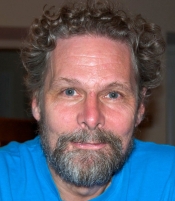By: Neil R. Swanberg and Robert Max Holmes, NSF's Arctic System Science Program Directors

"Does my idea for a proposal fit the Arctic System Science (ARCSS) program?" This is probably the most common question we hear from prospective researchers. Often the question is asked in a binary fashion—does it fit ARCSS or Arctic Natural Sciences (ANS)? In fact it was the frequency of this particular question that prompted us in the Arctic Sciences Section (then Division) to experiment for a few years in blurring the boundaries between ARCSS and ANS by holding a joint Arctic environmental competition. The intent was to make it easier for investigators to submit whatever ideas they wanted without worrying too much about programmatic boundaries. Moreover, we sought to avoid the situation of a proposal submitted to ARCSS that might have fared better in the broader review of an ANS panel.
An unintended and unexpected consequence of this experiment, however, was that we received far fewer proposals that attempted to fit ARCSS. Although as ARCSS Program Directors it is not our place to define what fits ANS, the fact is that many ARCSS proposals could fit ANS. So why submit to ARCSS? We think that question and the drop in ARCSS proposals over the past few years when ARCSS and ANS held joint competitions lie at the core of why there is an ARCSS program.
The results of the experiment demonstrate that if there were not a defined home for projects that are trying to look at the Arctic as a system, then that research would not happen, or at least not at the pace needed to advance the science. The existence of ARCSS serves as a beacon for those willing to make the extra effort that it takes to develop a project to study the Arctic as a system. This is the primary reason that ARCSS exists—so that the science of the complex Arctic system can advance.
What research is it that we think needs to occur? Let's be blunt. Almost everything you can think of in Arctic science is part of the Arctic system, so why shouldn't everything be included? The conversation usually goes like this, "My Topic (fill in anything) is terribly important. We don't understand aspect A of My Topic, and obviously cannot understand the Arctic system if we don't, so that is what we want to pursue." However, even though a particular topic may be an important part of the system, it is not necessarily a study of Arctic system science. ARCSS is trying to study the Arctic system itself, a complex system with emergent properties. A complex system is a set of interconnected components that have sufficiently complex interactions, which make the collection more than just the sum of its parts—that is, it demonstrates properties that emerge from the interaction of the parts and which cannot be predicted from the separate properties of the parts.

Such a system has behavior, can be self-regulatory, and very often behaves in surprising ways when perturbed. ARCSS is an earth-system science program, trying to explore the Arctic region as a system that possesses some particularly important properties in the context of the global Earth system. Following is a list of some of those properties as well as some comments, examples, or questions they prompt:
- Small changes in Arctic processes may lead to profound changes in the ways in which the Earth system operates. There are 'switches' or threshold responses. Examples are: loss of multi-year sea ice and its impact on various parts of the system, changes in precipitation, freshwater outflow and their potential impact on surface ocean layers, and the meridional overturning circulation.
- There are multiple uni- and bi-directional linkages between the Arctic region and the global system.
- Though there is forcing from outside the Arctic, the region functions somewhat as an entity and that functioning might change. There is self-regulation and emergent behavior. What processes keep the Arctic within its normal environmental 'envelope' and how are those processes changing in ways that will move it out of those bounds?
- Just like the Earth system, there are linkages in the Arctic that defy their study along disciplinary scientific boundaries. Changes in one parameter or process can have sweeping and sometimes unpredictable effects in other parts of the system. The scientific problems in the Arctic system transcend disciplinary boundaries across natural and social sciences and address all relevant aspects of marine, terrestrial, atmospheric, social, economic, and cultural components and processes within and across the Arctic region.
So what makes an ARCSS proposal? You probably can't address all of these things in every proposal and most of us are, at some level, disciplinary scientists exploring some addressable phenomenon. So how do you reconcile the scale of the individual science approach with the grand challenge from ARCSS? The classic science model is that each researcher does their bit of research, describes the results, and discusses them at the end of a paper. It is left to 'the community' to ingest that new knowledge. Global change programs realized long ago that this approach was not sufficient to address the really large complex problems on any reasonable time scale, which is why they pushed so hard to build networks of researchers with agreed-upon goals and coordinated synthesis activities. ARCSS too has emphasized this approach and will continue to do so. Another approach, also used by ARCSS, is multi-project, coordinated activities that address large aspects of the Arctic system. In this approach it is easier for an individual project to focus on a disciplinary problem while the organized effort addresses the system context. ARCSS funded numerous coordinated activities in the Freshwater Integration Study, which is an example of this approach. Other examples can be found in self-organized groups of Principal Investigators who write linked or collaborative proposals that collectively address the Arctic system. In this model, it is critical that at some point the collective results of the individual projects be synthesized rather than just collated.
However, ARCSS is not about big expensive projects, it is about big questions that address the Arctic as a system. Small projects can employ approaches that pro-actively study the system just as well as large ones. These may well look more disciplinary and local in nature, but still need to put their research in system context to be ARCSS proposals. This can be achieved by paying attention to several things, such as:
- Thoroughly document how important the process is that you are studying. All too often we see a paragraph in the introduction that explains how an important process is part of the system, and that is the last the Arctic system is mentioned. The proposal needs to demonstrate that it will actively bring the results back into system context (see below).
- One way to put your work in a system context is to explore feedbacks among system components. Which feedbacks related to the process being studied are negative and which positive, and what other parts of the system are affected? These approaches can lead to the discovery of emergent behaviors of the system and identify previously unrecognized linkages among parts of the system. They can also uncover potential surprises in system behavior such as threshold responses.
If you are studying impacts of change on some compartment or process, consider its overall vulnerability by examining multiple interacting drivers. For example, examine how warming, increased CO2, and changes in moisture can all combine to affect plants differently than each one would separately; or how surface water heating combined with changes in aerosols and snow cover conspire to affect sea ice. This can reveal much more complex interactions than looking at just one driver.
Ask truly interdisciplinary questions. Do not just use multiple disciplines to address a disciplinary question.
How can an individual project put its new knowledge back into our system understanding?
Consider including or collaborating with modelers to improve Arctic system or Earth system models based on the results of your project. Alternatively, have a plan to reach out to the communities that can use the new knowledge in a system context, maybe by holding a synthesis or outreach workshop.
Demonstrate that some other community is in need of the new knowledge. Don't just say, "This will help the modelers," show how it will.
- Identify what the new system understanding tells us about priorities for new research directions.
It is probably obvious by now that what makes a proposal ARCSS revolves around the questions it asks and how it approaches them. For this reason it is probably most important that you think about the 'ARCSS bit' well before you write the proposal. Retrofitting a proposal to fit ARCSS by inserting some text up front about the Arctic system is probably not an effective way to be successful. If the proposal is really about a specific disciplinary, or even interdisciplinary phenomenon, it may fit ANS better than ARCSS. If it directs its questions at how the system functions with regard to the phenomenon in question, then it may be ARCSS.
As always, we are eager to speak with investigators about their ideas for advancing Arctic system understanding. Please contact Neil R. Swanberg (nswanger [at] nsf.gov) or Robert Max Holmes (rholmes [at] nsf.gov).
